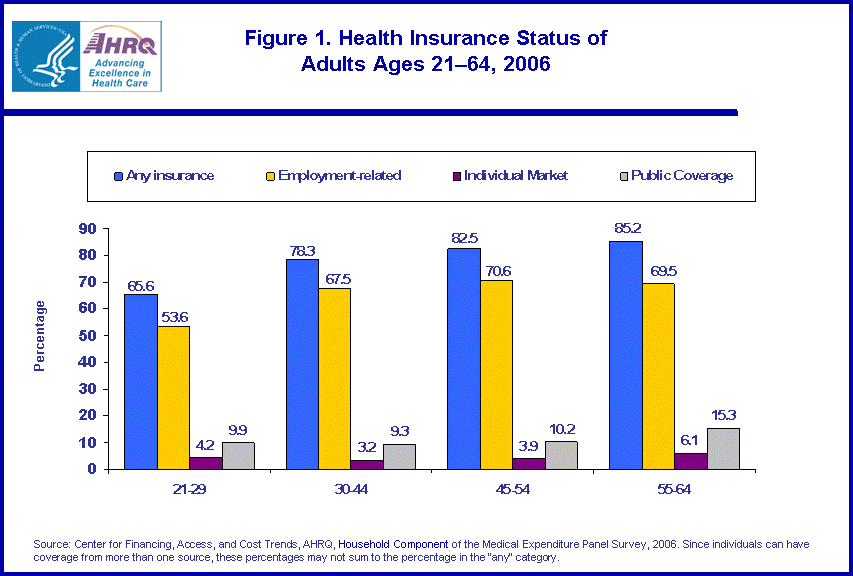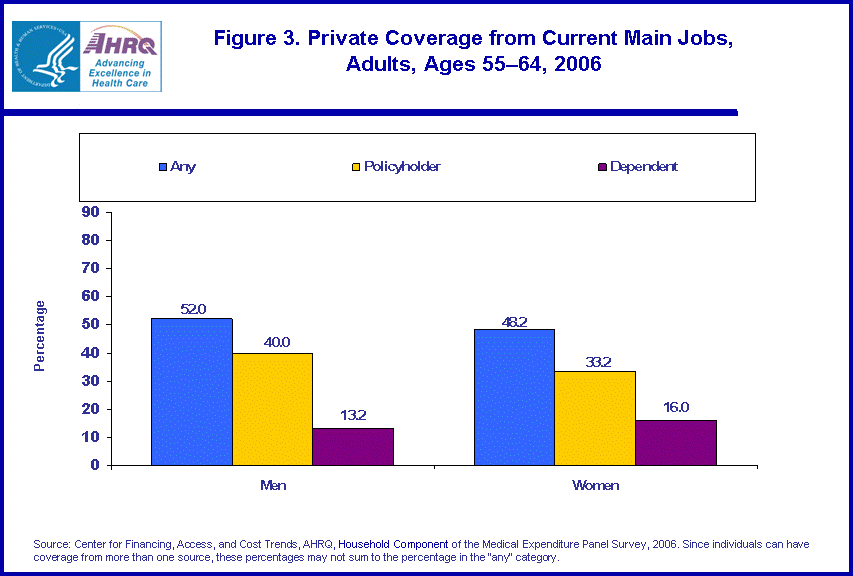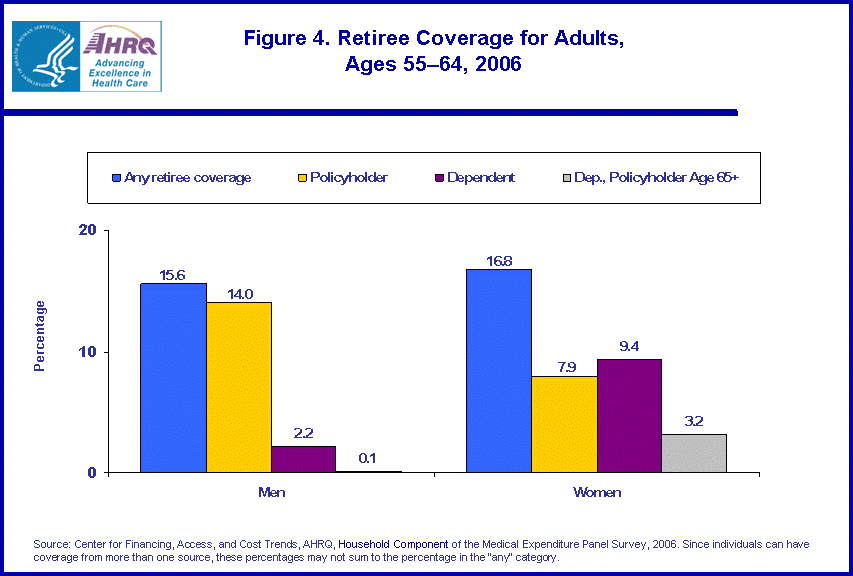
|
|
Font Size:
|
||||
|
|
|
|
||||
STATISTICAL BRIEF #239:
Health Insurance Coverage of Near Elderly Individuals, Ages 55-64, 2006
Highlights
- Near elderly adults were more likely to have health insurance than younger adults in December 2006 (85.2 percent of 55-64 year olds vs. 65.6 percent of 21-29 year olds, 78.3 percent of 30-44 year olds and 82.5 percent of 45-54 year olds).
- In December 2006, 69.5 percent of near elderly adults had employment-related coverage. About one-half (50.1 percent) had coverage from a current job, 16.2 percent had coverage from a retirement job and 5.7 percent had some other form of employment-related health insurance. These figures are not mutually exclusive and reflect the fact that some individuals have coverage from more than one source.
- Near elderly men were more likely than near elderly women to be a policyholder of coverage from a retirement job (14.0 percent vs. 7.9 percent, respectively). Near elderly women were more likely than near elderly men to be a dependent on such a plan (9.4 percent vs. 2.2 percent, respectively).
- Near elderly men were more likely than near elderly women be a policyholder from a current main job (40 percent vs. 33.2 percent).
Introduction
Although the vast majority of near elderly individuals are covered by private or public health insurance, those lacking coverage may be particularly vulnerable to the high health care costs associated with serious and chronic illnesses that emerge at older ages. Given the declines in the availability of retiree coverage and the use of medical underwriting in the individual health insurance market, it is important to study the insurance coverage of near elderly individuals. Using data from the Medical Expenditure Panel Survey (MEPS-HC), this Statistical Brief examines the sources of health insurance coverage of near elderly adults including whether employment-related coverage is obtained through a current job or a retirement job.
The near elderly population in this Statistical Brief consists of those individuals ages 55-64 who were in the U.S. civilian noninstitutionalized population in December 2006. Younger adults are included in this Statistical Brief for comparison purposes. All differences between estimates discussed in the text are statistically significant at the .05 level.
Findings
In 2006, near elderly adults were more likely to have health insurance than younger adults (85.2 percent of 55-64 year olds vs. 65.6 percent of 21-29 year olds, 78.3 percent of 30-44 year olds and 82.5 percent of 45-54 year olds). Their lower rate of uninsurance (14.8 percent) is due to higher rates of individual health insurance (6.1 percent) and public coverage (15.3 percent) than for younger adults. In addition, near elderly adults and those ages 30-54 were more likely to have employment-related coverage than the youngest adults, ages 21-29. Near elderly adults and those ages 30-54, had similar rates of employment-related coverage that ranged between 67.5 percent and 70.6 percent. While near elderly adults are less likely to be uninsured than younger adults, those lacking coverage are at increased risk for high health care costs since they are more likely to face a serious illness.
Near elderly adults' source of employment-related coverage differed from that for younger adults. For example, retiree coverage played a larger role in providing employment-related coverage to 55-64 year olds than to 45-54 year olds (16.2 vs. 1.4 percent) and coverage from a current job played a correspondingly smaller role (50.1 percent vs. 65.6 percent) (figure 2).
Figure 3 provides more detail on employment-related coverage obtained from a current main job for men and women. Near elderly men were more likely to be a policyholder of coverage from a current main job than near elderly women (40.0 percent vs. 33.2 percent).
While a similar percentage of near elderly men and women had retiree coverage in December 2006, men were more likely than women to be policyholders of retiree coverage (14.0 percent vs. 7.9 percent, figure 4) and less likely to be dependents (2.2 percent vs. 9.4 percent). Figure 4 also provides information on the percentage of near elderly adults who are dependents on a retiree health insurance policy with a policyholder age 65 or older. While almost no men are covered by such a policy, 3.2 percent of women are covered by a retiree plan with a policyholder age 65 or older. This represents about one-third of all women dependents of retiree coverage.
Data Source
The analyses in this Brief are based upon data from the MEPS 2006 Person Round Plan Public Use File: HC-103 and the MEPS 2006 Full Year Consolidated Data File: HC-105. Coverage through retirement jobs was constructed from linking data in the MEPS 2006 Person Round Plan Public Use File: HC-103 and the 2006 Jobs File: HC-100. These data are available at http://www.meps.ahrq.gov.
Definitions/Methodology
Age
Age is defined as age at the end of 2006.
Individual Health Insurance
Individual health insurance was defined as private health insurance that was obtained from sources other than an employer or union, including coverage from some other group, such as an association, as well as from non-group sources, such as an insurance company or HMO and coverage identified as being obtained by self-employed individuals with no employees. Individuals are classified as having individual health insurance if they have any of the above sources in December 2006.
Employment-related health insurance
Employment-related coverage was defined as including health insurance obtained through an employer or union. It also includes coverage through someone outside of the household or whose source was unknown, since both sources are likely to be employment-related. Individuals are classified as having employment-related health insurance if they have any of the above sources in December 2006. Employment-related health insurance was further categorized into insurance from a retirement job, a current main job, and other employment-related coverage which includes coverage from a previous (but not a retirement) job, coverage through someone outside of the household and coverage where the source is unknown. Retiree coverage as a dependent was further categorized by the age of the policyholder. For a small percentage of individuals, the policyholder's age was not available because the policyholder was not in the survey in December 2006.
About MEPS-HC
MEPS-HC is a nationally representative longitudinal survey that collects detailed information on health care utilization and expenditures, health insurance, and health status, as well as a wide variety of social, demographic, and economic characteristics for the U.S. civilian noninstitutionalized population. It is cosponsored by the Agency for Healthcare Research and Quality and the National Center for Health Statistics.
References
For a detailed description of the MEPS-HC survey and sample design, and methods used to minimize sources of nonsampling error, see the following publications:
Cohen, J. Design and Methods of the Medical Expenditure Panel Survey Household Component. MEPS Methodology Report No. 1. AHCPR Pub. No. 97-0026. Rockville, MD. Agency for Health Care Policy and Research, 1997. http://www.meps.ahrq.gov/mepsweb/data_files/publications/mr1/mr1.shtml
Cohen, S. Sample Design of the 1996 Medical Expenditure Panel Survey Household Component. MEPS Methodology Report No. 2. AHCPR Pub. No. 97-0027. Rockville, MD. Agency for Health Care Policy and Research, 1997. http://www.meps.ahrq.gov/mepsweb/data_files/publications/mr2/mr2.shtml
Cohen, S. Design Strategies and Innovations in the Medical Expenditure Panel Survey. Medical Care, July 2003: 41(7) Supplement: III-5-III-12.
Suggested Citation
Vistnes, J. Health Insurance Coverage of Near Elderly Individuals, Ages 55-64, 2006. Statistical Brief #239. March 2009. Agency for Healthcare Research and Quality, Rockville, MD. http://www.meps.ahrq.gov/mepsweb/data_files/publications/st239/stat239.pdf.
AHRQ welcomes questions and comments from readers of this publication who are interested in obtaining more information about access, cost, use, financing, and quality of health care in the United States. We also invite you to tell us how you are using this Statistical Brief and other MEPS data and tools and to share suggestions on how MEPS products might be enhanced to further meet your needs. Please e-mail us at mepspd@ahrq.gov or send a letter to the address below:
Steven B. Cohen, PhD, Director
Center for Financing, Access, and Cost Trends
Agency for Healthcare Research and Quality
540 Gaither Road
Rockville, MD 20850






